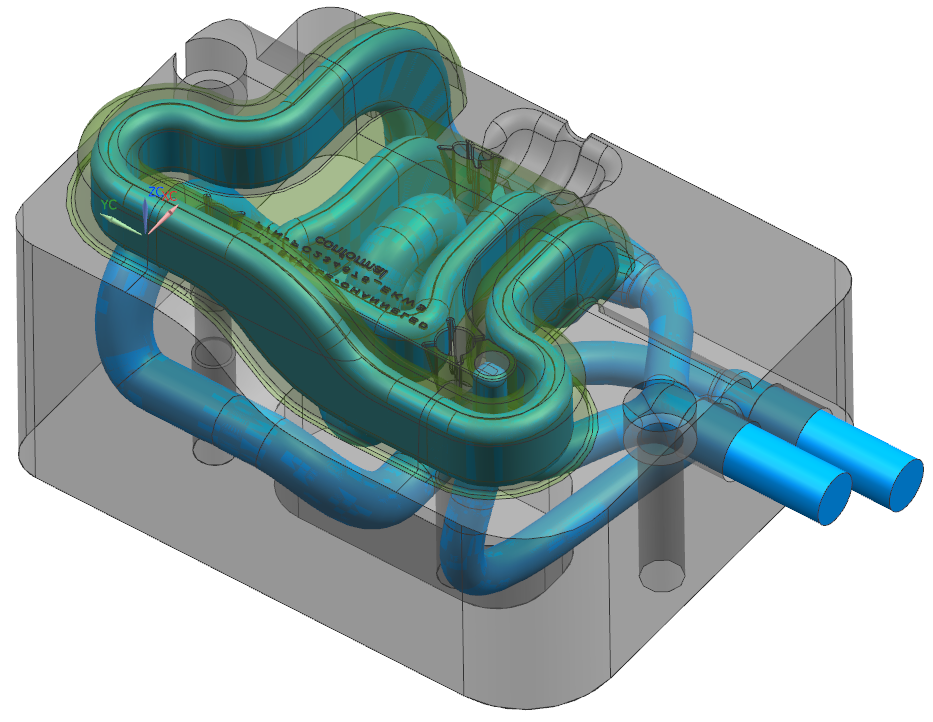
Industrial manufacturing is experiencing rapid growth and transformation with the use of advanced technologies like conformal cooling and additive manufacturing. Learn how conformal cooling works in injection molding and how it is transforming industrial manufacturing.
What is Conformal Cooling?
Conformal Cooling is a manufacturing technique that involves creating cooling channels or passages within a tool or mold that conform to the shape of the part being manufactured. Conformal cooling is most often used in plastic injection molding to reduce cycle times and improve part quality.
How Does Conformal Cooling Reduce Mold Cycle Time?
Conformal cooling provides precise heat regulation, optimizing cooling rates, and significantly reducing cycle times. Traditional cooling mechanisms designed in straight lines only provide coverage to a partial outline of the part’s geometry in the mold. Conformal cooling channels, however, are 3D printed to reach all the unique contours of a part’s geometry in the mold or tooling inserts.
Temperature control is crucial in injection molding, as the mold heats up when molten plastic is injected into it. With conventional cooling techniques, the temperature of the mold often rises over the threshold for ejecting a successful part–wasting time and money while the mold cools to an acceptable temperature for part ejection. Conformal cooling maintains a nominal temperature, allowing for a more rapid temperature reduction so that the overall cycle times are reduced each time the mold opens and closes.
By implementing conformal cooling, businesses can achieve remarkable results in terms of increased productivity and profitability. With cycle time savings, machinery and resources are freed up to produce other parts, unlocking manufacturing capacity.
In addition to these benefits, the efficient heat regulation provided by conformal cooling significantly improves overall efficiency. By optimizing cycle times, companies can allocate resources more effectively and avoid the need for additional equipment.
Materials Advanced by Conformal Cooling
Conformal cooling plays a pivotal role in improving quality of part production with a variety of materials, including nylon. Mold temperatures are quickly and subtly adjusted, allowing for precise control.
For materials that are heated to extremely high temperatures and require a more contracted cooling process, our engineers are also currently exploring variations like ‘conformal heating,’ using hot oil instead of water to cool molds when dealing with high-temperature materials.
Our engineers typically 3D print the cooling inserts in materials like Steel. Advanced technology like Direct Metal Laser Melting (DMLM) opens up endless opportunities in design and production making it possible to 3D print lines that follow the complex shape–including cross sections–of each part.
Avoiding Dimensional Issues
Quality or dimensional issues often stem from an inability to control the thermal delta (or heat difference) across the expanse of a part. High scrap rates, warpage, and distortion are all typical symptoms of uneven cooling. Conformal cooling helps maintain the dimensional integrity of the part, ensuring consistent quality and reducing waste.
While a typical customer may be running 50 to 80 parts an hour traditionally, with 3D printed conformal cooling inserts they can look forward to upwards of 140 parts per hour, making a huge difference in productivity for every manufacturing job.
What are Applications for Conformal Cooling?
There are a variety of parts and features that can benefit from using conformal techniques, across multiple industries. Objects like cups with handles, are a great example. Conformal cooling minimizes the potential for dimensional issues like shrinkage, distortion, warpage, and loss of structural integrity. Instead, manufacturers enjoy uniformity in parts, consistent quality for high-performing parts, and reduced waste during production.
To identify suitable applications for conformal cooling software like Moldex3D can be used for comprehensive analysis of molds, simulating flow patterns, cooling efficiency, and identifying potential issues like hot spots. This powerful software helps provide detailed data and visualizations, enable fine-tuning of conformal cooling parameters, and enhances part quality—allowing manufacturers to optimize production efficiency and produce larger volumes of parts.
Why do Manufacturers Use Conformal Cooling?
Manufacturers gain a significant edge in today’s competitive landscape with the ability to identify the correct applications and uses for conformal cooling. Efficient temperature regulation, reduced cycle times, improved part quality, and increased productivity are just some of the benefits offered by conformal cooling.
By leveraging the transformative potential of conformal cooling, businesses can thrive in a competitive market, setting new standards for productivity and excellence. See how Shapeways can help manufacturers with their conformal cooling needs.
Shapeways for Conformal Cooling
The impact and efficiency of conformal cooling can transform production for your company, and accelerate growth. In 2022, Shapeways further expanded its traditional manufacturing capabilities with the acquisition of Linear AMS, an expert in injection molding known for innovative solutions like conformal cooling. Linear’s true, consultative approach made them a trusted partner in solving the toughest manufacturing challenges and Shapeways has continued with that legacy.

